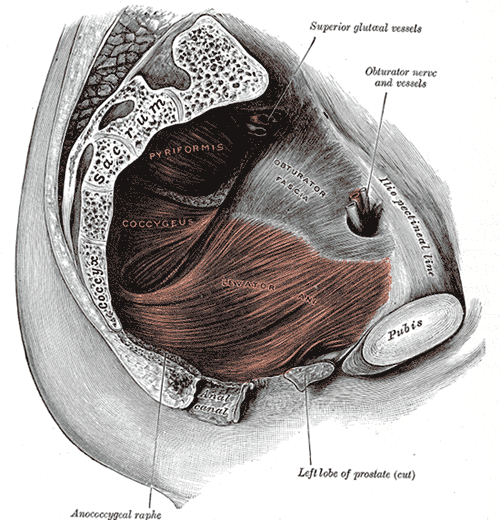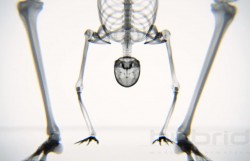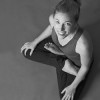
What constitutes the “groin” area?
The group of adductor muscles located in the inner thigh between the quadriceps on the front of the leg and the hamstrings on the back are often referred to as the “groin.” This group of five muscles includes the adductor magnus, adductor longus, adductor brevis, pectineus, and gracilis.
The adductors, which fan out across the upper thigh, work to pull the legs together when they contract and help to stabilize the hip joint (assisting as hip flexors, extensors, and rotators). The adductors originate or attach at the pelvis (sitting bone) and connect to the femur (thigh bone).
The adductors as a group are approximately the same size as the quads (four part muscle group) and hamstrings (three part muscle group). The two shorter muscles, the pectineus and adductor brevis, insert on the upper posterior femur (thighbone). The two longer muscles, the adductor longus and adductor magnus, insert on the middle and lower area of the posterior femur. The gracilis, latin for “slender,” is a thin, flattened, strap—like muscle that connects the pubic bone to the tibia below the knee. It’s the most superficial muscle on the medial side of the thigh.
Common Injuries
Groin injuries are one of the most common injuries among physically active individuals, particularly athletes participating in competitive sports. According to research by Vincent Morelli, MD at Louisiana State School of Medicine, the diagnosis of groin pain can be very difficult given the complex anatomy of the region. Often two or more injuries coexist. The most common musculoskeletal groin injuries among athletes are adductor strains and osteitis pubis, two injuries often difficult to distinguish. Other injuries causing groin pain may include sports hernia, groin disruption, iliopsoas bursitis, stress or avulsion fractures, nerve compression, and snapping hip syndrome.2
The most common area of groin strain is the musculotendinous junction of the adductor longus or gracilis. According to Marlon P Rimando, MD, “the adductor tendons have a small insertion area that attaches to the periosteum-free bone. This transitional zone is characterized by a poor blood supply and rich nerve supply, explaining the high level of perceived pain and poor healing characteristics of adductor strains.3″
Groin injuries are often caused by a sudden change in direction or quick starts and stops while running in field or court sports. The most common sports that lead to increased risk of adductor injury include football, soccer, hockey, basketball, tennis, figure skating, baseball, horseback riding, karate, softball, and running (sprinting or running uphill).3
The adductors help provide the basic stability needed for many daily functions as they work to hold the inner thigh together. For example, while walking each day, the adductors work to keep the legs from buckling outward under the full weight of the body. There are many other simple daily functions that require the use of adductors to bring the legs together such as putting pants on one leg at a time, getting into and out of the car, getting into and out of bed, among others functions.
Yoga Therapy To Prevent and Heal Groin Injuries
A regular yoga practice can be very beneficial in preventing groin injuries. Groin pain is often the result of an adductor muscle stretched beyond its limits. Properly stretching the groin muscles on a regular basis to increase flexibility can significantly reduce the risk of injury. Additionally, weakness of the adductors can lead to increased risk of injury as the “load to failure” is much less in weaker muscles (i.e. the muscles are less able to support weight or resist force).3 As such, a preventative yoga therapy program should include a balance of adductor strengthening postures, active poses that both strengthen and lengthening the adductors, and passive adductor stretches.
When a groin tear does occur, small tears in the adductor muscles cause pain and swelling. A severe tear can cause sudden acute pain, swelling, and bruising. The area is typically painful to the touch, with increasing pain felt with resistance movements and stretching of the inner thigh and hamstrings.
During the period of acute pain, its generally recommended to rest the area of injury to prevent further injury and inflammation. After acute pain subsides, the initial goal of Yoga Therapy should be to restore comfort, range of motion, and prevent atrophy. As such, a restorative and/or gentle slow flow class may be most appropriate. As range of motion is restored without physical discomfort, the client may be ready to begin to rebuild strength, flexibility, and endurance. This process may take anywhere from four weeks to six months, depending on the severity of the injury.
Yoga Poses that Work to Strengthen The Adductors (Groin Muscles Contracting)
When the adductor group of muscles are actively working they contract to bring the thighs together. This is required in many poses in which the practitioner hugs or crosses “the midline.” Additionally, the adductors work in many postures to internally rotate the thigh, such as in one leg balancing postures (standing leg). As such, adductors may be strengthened through:
Warrior I (Virabhadrasana I)—As you work to “square” your hips to the front of your mat or roll your inner thighs together your adductors work as a group to contract.
Eagle Pose (Garudasana)—Adductor magnus contracts to hold this pose.
Chair Pose (Utkatasana)—Adductor group works to keep legs together at midline.
Tree Pose (Vrksasana)—The adductor magnus (extensor portion) is working in the lifted leg.
Warrior III (Virabhadrasana III)—As you internally roll the thighs to keeping the pelvis stable at midline you engage the adductors.
Dancer (Natarajasana)—The adductor magnus is working as both an adductor and hip extensor.
Boat Pose (Navasana)—The gracilis and pectineus work to adduct, bringing the legs to midline, and flexing the hip joints.
Camel (Ustrasana)—The adductor magnus works concentrically with the hamstrings to stabilize the knee and hip joints in the posture.
Bridge (Setu Bandhasana)—The adductor magnus works to extend, internally rotate, and adduct the hips.
Inversions—The adductor magnus and pectineus works to adduct, internally rotate, and extend the legs holding them at midline. In shoulder stand, the pectineus also works to flex the legs when not fully stacked.
Arm Balances (Scissors or Eight Angle Pose, Crow Pose, Crane Pose, Side Crow, Peacock)—Within most arm balancing postures the adductors of the inner thighs need to be strong enough to hug the midline. For example, in crow, if your legs slide down your arms this is typically due to weakness of the adductors unable to squeeze the thighs against the arm bones, which provides stability allowing you to use your abdominals to lift.
The adductor magnus works in conjunction with other muscles to in internally rotate the thighs and keep the knees together in many yoga postures including Locus Pose (Salabhasana), Plow Pose (Halasana), Cobra (Bhujangasana), Bow Pose (Dhanurasana), Uopward Facing Dog (Urdhva Mukha Svanasana), Upward Plank Pose (Purvottanasana), Upward Bow or Wheel (Urdhva Dhanurasana), Side Plank (Vasisthasana), and Reverse Table (Chatus Pada Pitham) among other yoga postures.

Yoga Poses that Stretch and Lengthen The Adductor Muscles
Active Stretching Poses:
Standing Wide Legged Forward Bend (Prasarita Padottanasana)—All five muscles within the adductor group are lengthening. Additionally, the adductors are eccentrically working against the weight of the body falling towards the floor.
Warrior II (Virabhadrasana II)—Done with awareness in which the front knee is not allowed to collapse inward, this pose stretches all five hip adductors. The adductor group of muscles in the inner thighs pull the knees towards midline or towards each other. Working against that tendency to keep the knee from collapsing in will stretch these muscles lengthening the pectineus, adductor brevis, adductor longus, adductor magnus, and gracilis in the front leg. You can also try warrior II lying on your back with you feet against a wall for a more passive stretch.
Extended Side Angle Pose (Utthita Parsvakonasana)—See above.
Goddess Pose (Utkata Konasana)—Stretches the groin muscles.
Standing Extended Big Toe Hold (Utthita Hasta Padangustasana)—By extending the lifted leg out to the side this pose will actively stretch the adductor group.
Triangle Pose (Utthita Trikonasana)—This posture lengthens all five adductors muscles within the groin (pectineus, gracilis, adductor magnis, minimus, longus, brevis) in the front leg.
Gate Pose (Parighasana)—Lengthens the adductor magnus and gracilis in the extended leg.
Yogi Squat or Garland Pose (Malasana or Upavesasana)—Lengthens the adductor longus and adductor brevis. The gracilis is not stretching due to knee flexion.
Tree Pose (Vrksasana)—Within the groin, this posture lengthens the pectineus, adductor longus, adductor brevis, and gracilis in the lifted (bent) leg.
Passive Poses:
Bound Angle (Baddha Konasana)—Provides a deep stretch for the adductor magnus. Also stretches the adductor longus and brevis, and gracilis muscles. To deepen the stretch for the gracilis, further extend the knees.
Seated Wide Legged Forward Fold (Upavistha Konasana) and Turtle Pose (Kurmasana)—The gracilis is the most stretched of the adductors because of the knee extension. While the other adductors also receive a stretch, the pectineus is least stretched because of the hip flexion.
Reclining Extended Big Toe Hold (Supta Padangusthasana)—With the leg extended out to the side the adductor magnus, gracilis, and pectineus are lengthened.
Fire Log Pose (Agnistambhasana)—Stretches the hip and groin muscles.
Happy Baby Pose (Ananda Balasana)—Stretches the adductor muscles and hamstrings.
Head-To-Knee Pose (Janu Sirsasana) and Revolved Head to Knee Pose (Parivrtta Janu Sirsasana)—Adductor muscles of the folded leg are lengthening. “The adductor magnus mainly stretches because it creates internal rotation, extension, and adduction (as in baddha konasana). The adductor longus and brevis also stretch because they flex and externally rotate the leg (abduction lengthens these two). The more the legs are externally rotated and abducted, the more the pectineus is lengthened.1“
Reclining Hero Pose (Supta Virasana)—Lengthens the adductor longus and brevis due to internal rotation and extension and the pectineus due to hip extension.
These Yoga Therapy tools are meant to be helpful in preventing and healing adductor and groin injuries in you and your Yoga Therapy clients.
Sources
- “Yoga Anatomy” by Leslie Kaminoff Illustrated by Sharon Ellis Copyright © 2007 by The Breathe Trust
- ” Groin Injuries in Athletes” by VINCENT MORELLI, M.D., Louisiana State University School of Medicine, New Orleans, Louisiana and VICTORIA SMITH, M.D., Louisiana State University Health Sciences Center, Kenner, Louisiana. Am Fam Physician. 2001 Oct 15;64(8):1405-1415. http://www.aafp.org/afp/2001/1015/p1405.html
- “Adductor Strain” by Marlon P Rimando, MD, CSCS Assistant Clinical Professor, Department of Medicine, University of Hawaii, John A Burns School of Medicine; Founder, Pacific Health and Fitness Consultants http://emedicine.medscape.com/article/307308-overview
- http://www.yogajournal.com/practice/2678
- http://sportsmedicine.about.com/cs/hip_groin/a/hip2.htm
- http://sportsmedicine.about.com/od/glossary/g/Adductors_def.htm
- http://www.foxnews.com/story/2009/06/19/top-10-sports-injuries/
- http://www.yogajournal.com/for_teachers/2040
- http://www.yogajournal.com/practice/1982
- http://www.elephantjournal.com/2013/09/the-subtle-importance-of-adductors-terra-milander/
Love elephant and want to go steady?
Sign up for our (curated) daily and weekly newsletters!
Editor Assistant: Jessica Sandhu/ Editor: Catherine Monkman
Photo: elephant journal archives
 Share on bsky
Share on bsky

Read 3 comments and reply